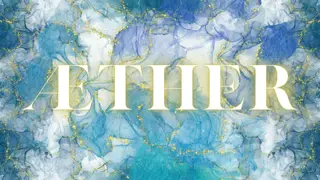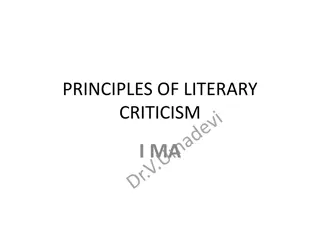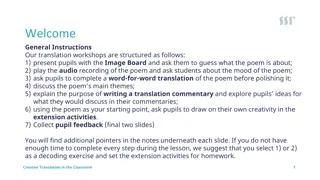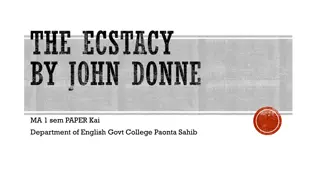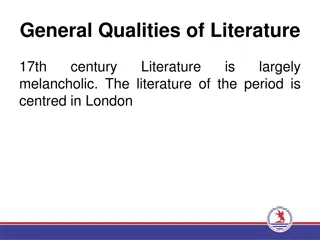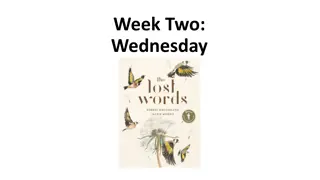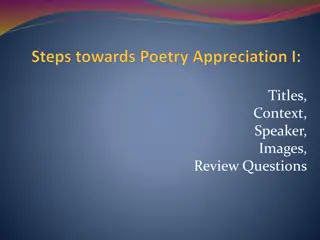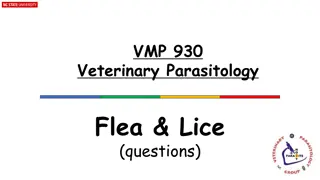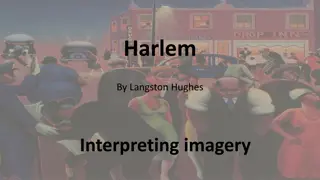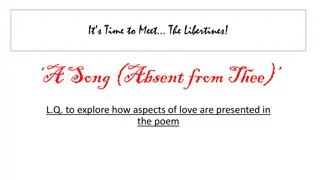Analysis of "The Flea" by John Donne: Detailed Study of a Metaphysical Poem
The poem "The Flea" by John Donne explores the notion of physical intimacy through the metaphor of a flea. The speaker uses the flea as a symbol to persuade his beloved to engage in a physical relationship, arguing that their union is already consummated within the body of the flea. Despite the lover's initial attempt to kill the flea, the speaker convinces her that the act of killing it would be sacrilegious and unnecessary. Through clever wordplay and persuasive imagery, Donne crafts a complex argument on love and intimacy that challenges societal norms and expectations.
Download Presentation

Please find below an Image/Link to download the presentation.
The content on the website is provided AS IS for your information and personal use only. It may not be sold, licensed, or shared on other websites without obtaining consent from the author.If you encounter any issues during the download, it is possible that the publisher has removed the file from their server.
You are allowed to download the files provided on this website for personal or commercial use, subject to the condition that they are used lawfully. All files are the property of their respective owners.
The content on the website is provided AS IS for your information and personal use only. It may not be sold, licensed, or shared on other websites without obtaining consent from the author.
E N D
Presentation Transcript
I. B. PG COLLEGE PANIPAT
PRESENTED BY Professor Priya Bareja Department of English I. B. PG College ,Panipat
CLASS M. A. ENGLISH ( PREVIOUS YEAR ) SUBJECT LITERATURE IN ENGLISH 1550-1660(II) TOPIC THE FLEA BY JOHN DONNE
The Flea SUMMARY The speaker tells his beloved to look at the flea before them and to note how little is that thing that she denies him. For the flea, he says, has sucked first his blood, then her blood, so that now, inside the flea, they are mingled; and that mingling cannot be called sin, or shame, or loss of maidenhead. The flea has joined them together in a way that, alas, is more than we would do.
As his beloved moves to kill the flea, the speaker stays her hand, asking her to spare the three lives in the flea: his life, her life, and the flea s own life. In the flea, he says, where their blood is mingled, they are almost married no, more than married and the flea is their marriage bed and marriage temple mixed into one. Though their parents grudge their romance and though she will not make love to him, they are nevertheless united and cloistered in the living walls of the flea. She is apt to kill him, he says, but he asks that she not kill herself by killing the flea that contains her blood; he says that to kill the flea would be sacrilege, three sins in killing three.
Cruel and sudden, the speaker calls his lover, who has now killed the flea, purpling her fingernail with the blood of innocence. The speaker asks his lover what the flea s sin was, other than having sucked from each of them a drop of blood. He says that his lover replies that neither of them is less noble for having killed the flea. It is true, he says, and it is this very fact that proves that her fears are false: If she were to sleep with him ( yield to me ), she would lose no more honor than she lost when she killed the flea.
Form This poem alternates metrically between lines in iambic tetrameter and lines in iambic pentameter, a 4-5 stress pattern ending with two pentameter lines at the end of each stanza. Thus, the stress pattern in each of the nine- line stanzas is 454545455. The rhyme scheme in each stanza is similarly regular, in couplets, with the final line rhyming with the final couplet: AABBCCDDD.
Commentary This funny little poem again exhibits Donne s metaphysical love-poem mode, his aptitude for turning even the least likely images into elaborate symbols of love and romance. This poem uses the image of a flea that has just bitten the speaker and his beloved to sketch an amusing conflict over whether the two will engage in premarital sex.
The speaker wants to, the beloved does not, and so the speaker, highly clever but grasping at straws, uses the flea, in whose body his blood mingles with his beloved s, to show how innocuous such mingling can be he reasons that if mingling in the flea is so innocuous, sexual mingling would be equally innocuous, for they are really the same thing. By the second stanza, the speaker is trying to save the flea s life, holding it up as our marriage bed and marriage temple.
But when the beloved kills the flea despite the speakers protestations (and probably as a deliberate move to squash his argument, as well), he turns his argument on its head and claims that despite the high-minded and sacred ideals he has just been invoking, killing the flea did not really impugn his beloved s honor and despite the high-minded and sacred ideals she has invoked in refusing to sleep with him, doing so would not impugn her honor either.
This poem is the cleverest of a long line of sixteenth-century love poems using the flea as an erotic image, a genre derived from an older poem of Ovid. Donne s poise of hinting at the erotic without ever explicitly referring to sex, while at the same time leaving no doubt as to exactly what he means, is as much a source of the poem s humor as the silly image of the flea is; the idea that being bitten by a flea would represent sin, or shame, or loss of maidenhead gets the point across with a neat conciseness and clarity that Donne s later religious lyrics never attained.



